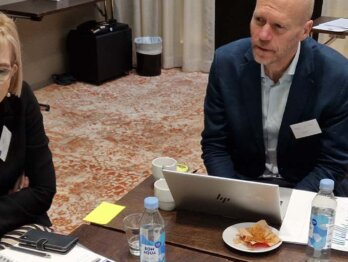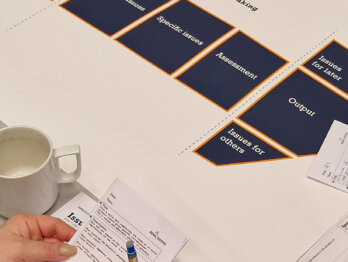Remembering the ‘why’ of innovation

“We create and re-create narratives throughout our lives to make sense of what happened, to process experience, to interpret and reinterpret our view of the world as life unfolds. I believe that beautiful and difficult process is what it is to be human.” Lauren Oakes
For me, significant transitions in life prompt such introspection and recreation of narratives – to reflect on key moments that have shaped who I am and how I think. Recently, I packed up my life in Canberra and moved to a different hemisphere in a time where even leaving the shores of Australia seemed incomprehensible. After 14 years working within and for the Australian Government, I have taken a leave of absence to be part of the OECD in Paris, supporting public servants to adopt innovative approaches to achieve positive shifts for the community.
This significant transition has prompted me to think a lot about the years I have recently spent working as a Senior Executive in the Australian Public Sector. From 2019, I worked with some of the most wonderful, passionate and intelligent humans to help the Australian Taxation Office develop and embed a new approach for delivering change (systems-led design) that reflects the complex reality of the world around us.
These years taught me a lot about the techniques and collective hard work it often takes to move systems approaches and innovative methods from a theoretical concept into tangible outcomes.
To kick things off, I will share why I believe that modernising and innovating the way governments work is important. I will also run through some recent criticisms of innovation, and explore whether the obsession with ‘innovation’ as a measure of success can distract public servants from the results they need to deliver.
An innovation success story in the era of COVID-19
“The world has become so complex that the idea of a power in which everything comes together and can be controlled in a centralised way is now erroneous” – Ulrich Beck
The last 18 months has forced us to contend with the complexity and interconnectedness of the world around us. The COVID-19 outbreak has transformed the fabric of social and economic society, and its impacts have transcended any single policy domain. The pandemic has exposed the flaws of our current paradigm ofpolicymaking and public management. It revealed the limitations of our existing approaches for working with complexity to consider, analyse, design and deliver on policies.
Yet, governments did ultimately show they could innovate to achieve the impossible, even in highly challenging conditions, something we have been tracking and celebrating here at OPSI. Governments focused on collective agendas, worked across siloes, rethought with compliance and regulatory posture, engaged with citizens in more open ways, shifted where scrutiny should concentrate, delivered iteratively and quickly, intentionally adopted new technology, collaborated across sectors and borders, and mobilised staff and expertise differently. There was a true recognition that new, innovative approaches were required administer public services.
I observed such shifts in my own work when designing one of Australia’s largest government responses, the JobKeeper Program, a wage subsidy paid to businesses significantly impacted by COVID-19. An organisation of over 20,000 people was rapidly refocused to deliver the most important mandate of the day – using JobKeeper and other stimulus measures to support those who needed it most. We drew on expertise from across the ATO in order to design and develop quickly and iteratively. We released the program in record speed, iterated when we could identify what worked (and what did not). At the same time, we were under intense public scrutiny, and had to open with citizens about its experimental nature. These scrutiny measures highlighted important contextual factors that affected the uptake and impact of the program, and helped us to ensure that we provided support for citizens who needed it. We collaborated at a global level to share and apply insights. Our staff learned new skills and worked to help our client in different ways. Ultimately, we created something that helped society in a new way in a new and uncertain environment.
This example demonstrates why innovation in government should be supported. It is only one example from Australia, but I have seen similar challenging conditions and impressive examples of innovative practice across global contexts. More importantly, I know that the biggest issues today, many which have been catalysed by the pandemic, span across nations. For this reason, we not only need to innovate within country contexts; we also need to work across the globe in more genuinely collaborative and innovative ways. This is one reason I am excited to be here in the OECD, to be able to bring the experiences and learnings from my Australian context to help public sectors across the globe embrace and gain benefit from innovating both in their contexts, but also across borders.
We all hope that the pressurised, uncertain conditions global public sectors are facing this minute are not sustained. However, complexity in our world, and in policymaking, is not going away. Having learned so much since early 2020, we must now seize the present opportunity to engage with the complexity made stark through COVID-19. We need to rethink our paradigms, and to innovate our public policy and management practices.
Signals of growing ‘innovation hesitancy’
“Dialogue starts with the willingness to challenge our own thinking, to recognise that any certainty we have is, at best, a hypothesis about the world” – Peter Senge
In spite of our recent successes, I have noticed signs that the wave of enthusiasm for innovation may have started to crest. Some senior leaders are now scrunching up their nose when they hear the word spoken aloud. Public servants have suggested the reality of innovation does not match the hype. I have even seen entire organisations shift away from innovation agendas. In recent months, the ATO moved away from innovation teams and innovation frameworks. The Australian Public Service ceased the Public Sector Innovation Network earlier this year.
For those of us working in public sector innovation, these signals can be dispiriting. But we must remember that our goal is not to champion innovation for its own sake, or to criticise those who do not believe in its advantages. Our goal is to help public servants innovate to address the challenges they face. To achieve this, it is necessary to understand their hesitancy around innovation.
I have observed a number of perspectives, which contribute to hesitancy around innovation, innovating and even innovators. The first is that public servants working everyday are unable to change existing things when they have to deliver outcomes – in other words, they cannot rebuild the car while they are driving it. The second is a belief that innovation teams impose the theory of innovation without grounding it in practice – they do not truly understand the context of the business or policy area or the constraints in which they are working leaving such efforts little more than theatrics with little tangible results. The third arises from those public servants who feel alienated, left behind or disempowered because of the hype, dogmatism, jargon and elitism that can spur around innovation and innovation groups. Fourth, some have experiences of innovative practices or functions that are not integrated intentionally into the broader system, making them more of a nuisance to work around rather than something to embrace.
I believe that these perspectives are connected by a larger trend. Over the past few years, innovation has been fetishized in both the private and public sectors. In raising innovation up as a solution to the world’s problems, many have forgotten that innovating the way we do things or producing innovative new tools has purpose: to help achieve public goals and address knotty challenges.
To deliver on the promises of innovation, we must innovate with purpose
What happens when we talk about innovation without connecting it to purpose?
In some cases, the answer to this question is: nothing happens. The Australian Public Service Commission’s paper on wicked problems from 2007 sparked a wave of conversation on doing things differently. Despite local examples in Australia and globally of new practices, the fundamental bones of public sector management now are not markedly different.
In other situations, the impact can be more negative. A recent book, the Innovation Delusion, highlighted for me the potentially negative impacts of an emerging ideology of innovating for innovation’s sake. The list is long. Money wasted on innovation agendas that failed to gain any support or implement meaningful change. New government services that lack the ease and intuitive of private industry disrupters. Disruption of existing things that work well. New and innovative digital apps that did not serve the needs of their customers, and even put their privacy at risk. We even have extravagantly produced virtual assistants voiced by academy award winners that never made it beyond promotional materials.
These examples show that the value of public sector innovation is rightly under review. Too often, the purpose of public sector innovation is forgotten, along with the people it is intended to serve.
“A noble purpose inspires sacrifice, stimulates innovation and encourages perseverance” Gary Hamel
To innovate well in the public sector, we need to consider why we are innovating. Innovation is an enabler, a mechanism, a way of thinking, and a strategy to help us achieve a purpose. It is not for its own sake. As we have shown through our Innovation Facets Portfolio model, innovation can be directed towards different purposes and actually taking a diversified approach is highly beneficial. Whether we are putting out an innovative program or product, or adopting an innovative approach, the point is that it is only there to help a nobler goal of achieving public value, a better society. Despite the promises of ‘exponential scaling’ often touted by innovators in the private sector, good public sector innovation should be about quality, not quantity. Whether we are developing a new thing, or adopting a fresh approach, it is necessary to tailor public sector innovation to the complex idiosyncrasies of our current moment.
I suggest we need to shift away from celebrating the volume of public sector innovation or the shiniest or most aggressive innovation to championing and learning from individuals, teams and public sectors who innovate through a clear understanding of their purpose. This purpose-driven innovation may be slower than innovation with scale in its sights. It may be smaller or less shiny. It may be about shifting engrained practices. However, these aspects should be celebrated as features of innovation in the public sector, not bugs. They are indications that innovation is being done sensitively, and is conscious of the needs and experiences of those delivering policy, as well as the citizens it ultimately affects.
“There’s no greater challenge and there is no greater honor than to be in the public service” – Condoleezza Rice
If we remember the reasons that so many of us are passionate about shifting and pushing the boundaries of the public sector and ensure our efforts are reflective of its context, we will have a better chance of igniting magic and creating enduring outcomes for society.
This is why I am leading the next phase of the OECD Declaration on Public Sector Innovation and extending on our work with countries how to understand and foster public sector ecosystems that are innovative and can leverage innovations to achieve their goals. My focus will be on leveraging the credibility and legitimacy the OECD Declaration on Public Sector Innovation offers globally and working with countries to enable it to inform action on addressing public sector outcomes, while considering how innovation is practically embedded at the individual, organisational and public sector whole of system level. Ultimately, so I can help innovating more practical, connected to purpose and a truly embedded part of public policymaking and administration. I would love to connect with you on insights or learnings you have that can help us shape this work or would like us to consider what it means for your own context.
I look forward to sharing with you over the coming months of my own learnings and the work we do here in the OECD.












